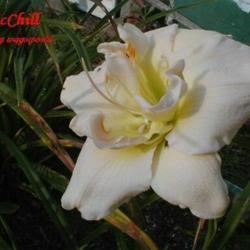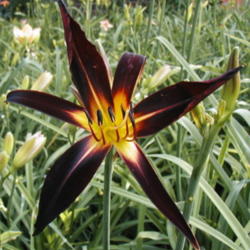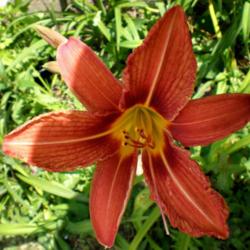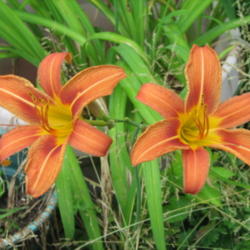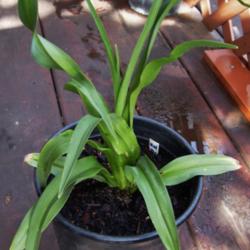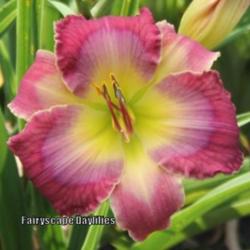Chapter 2: Form and Species (just my take on it

)
This chapter reviews the past use of F1/Mendellian hybridization models (sibling crosses to show simple white and purple pea flower color inheritance ratios) and then further explores McGarty’s F0/Gene-rations model (my word for his notation that shows how many generations a seedling is from its species and/or ancestors in order to track and show complex changes that the Mendellian model cannot). With the Mendellian model, plant breeders assumed a simple one-to-one mapping of colors to single genes, but this method quickly falls short of explaining the wide variation and gradations produced in daylily colors and patterns. So, to examine the more complex color expressions in hemerocallis, McGarty focuses our attention toward how color is produced first within the genetic/cell system itself, and then as part of an interconnected pattern of color production within petals and blooms.
Such a Range of Colors
The chapter opens by re-emphasizing the importance of using of our senses to observe, not just by looking, but by multiple senses, the unique characteristics and differences found in species plants. They are first and foremost the genetic pool of ancestors from which our modern-day cultivars have descended. Leaf and petal texture, various scents, the patterns in time for when they bloom, each characteristic is produced from genetic codes that get woven into subsequent generations. Physical systems form the outward details of what we all observe and highlights the importance of our own careful and detailed observation for understanding how daylily genes (the genotype) create the phenotype (external physical characteristics) of each plant.
One of the Foundational Species
Genotype refers to specific DNA and RNA that create protein codes resulting in the formation of genes in each cell that direct how physical attributes will appear and function. Because nucleic acids (the NA in DNA/RNA) can randomly re-combine, that creates a wide variety of how inherited characteristics may be expressed. For example, the F1 generation of offspring from McGarty’s own experimental breeding of fulva species with citrina species included offspring that had petal, stamen, and pistil lengths and widths that both undershot and overshot their species parents. This demonstrates that Mendellian-type associations of one-set-attribute-to-one-gene does not explain inheritance in daylilies, or only lengths and widths identical to either one of the parents would have been produced. Instead, the complex pattern of inheritance mixes, matches, and spreads attributes across a wider spectrum, while clustering most inherited attributes much like a bell curve around a general range of characteristics expressed by the parents.
Roots: Short and Bulbous, Mixed, and Long and Thin
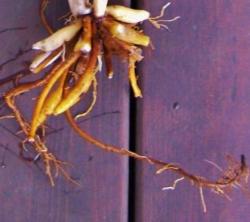
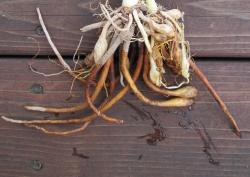

He returns from his discussion on genes to focus once again on the importance of first looking at and then classifying the physical details of species plants. To start, he outlines the ways in which phenotype can be classified, and mentions that genotype classifications will be covered in a later chapter. The first of the phenotype classifications is: Form. Form refers to the physical nature of the different parts of the plant, and for purposes of his book, they are limited to roots, leaves, buds, flowers, and seed pods. Narrowing the focus like this should help us observe and remember differences as we learn how to identify our daylily species plants.
Leaves: Grass Thin, Full and Twisting, Classic Fan
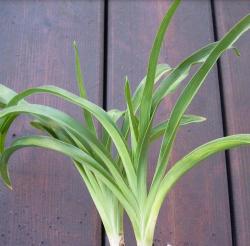
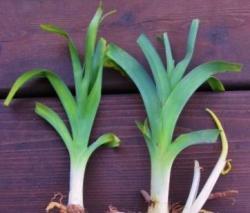
The examination of roots will focus on the shape and size of the plant’s water absorbing system for nutrient storage and transport. Leaves with varying widths and lengths are the structures in which chlorophyll processes and creates energy for the plant. Buds of different shapes and sizes extend out from scapes of various thickness, height, and branching, depending on the cultivar. And species flowers, which now have descendants showing highly variable colors and physical characteristics, are formed with three inner petals, three outer sepals, six pollen stamens, and one female pistil that leads to an ovary. Pods are fertilized ovaries that produce and house seeds.
Buds: Balloon, String Bean, Whitish Color
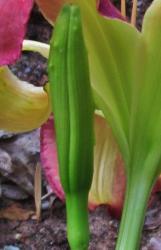
I’ll stop here for now, as the remainder of the chapter is full of wonderful descriptions and pictures that explore differences in those five form characteristics found between the main species. I like to learn by recreating the process by which something is taught, and so I will see if I can assemble ATP database and other free-use photos to show what he describes of the identifying characteristics of the relatively few daylily ancestors behind today’s modern cultivars.
Petals and Sepals, Stamen and Pistil, Fertilized Seed Pod
